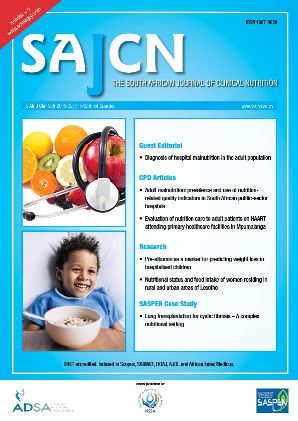Adult malnutrition: prevalence and use of nutrition-related quality indicators in South African public-sector hospitals
Abstract
Objectives: The aim of this study was to describe the prevalence of malnutrition among adult hospitalised patients in three South African public hospitals and to determine the availability of nutrition-related quality indicators at ward and institutional level.
Method: A descriptive, cross-sectional, multi-centre study was used to determine the prevalence of malnutrition, whilst a descriptive exploratory design was used to determine the use of nutrition-related quality indicators for the identification and treatment of malnutrition. A total of 141 adult hospitalised patients in three public hospitals in an urban setting participated. Mid-upper arm circumference (MUAC), body mass index (BMI), and malnutrition universal screening tool (MUST) were used to determine the prevalence of malnutrition or malnutrition risk. A Hospital Nutrition Review Tool (HNRT) determined the use of nutrition-related quality indicators.
Results: The overall malnutrition risk according to MUST was 72.3% (48.2% high risk and 24.1% medium risk), whilst 45.4% were malnourished based on MUAC. No routine nutritional screening was conducted in any of the wards to identify patients at nutritional risk. The majority of nurses reported inadequate training or knowledge to calculate patients’ BMI or percentage weight loss, or to perform nutritional screening.
Conclusion: Both malnutrition prevalence and malnutrition risk among adult hospitalised patients are high in the public sector. Inadequate resources may lead to delays in malnutrition identification and appropriate nutritional intervention, which may adversely affect both the patient and the institution. This study contributes to baseline data on adult malnutrition in the South African public hospital setting.
Full text available at https://doi.org/10.1080/16070658.2017.1410003
The SAJCN does not hold itself responsible for statements made by the authors.


